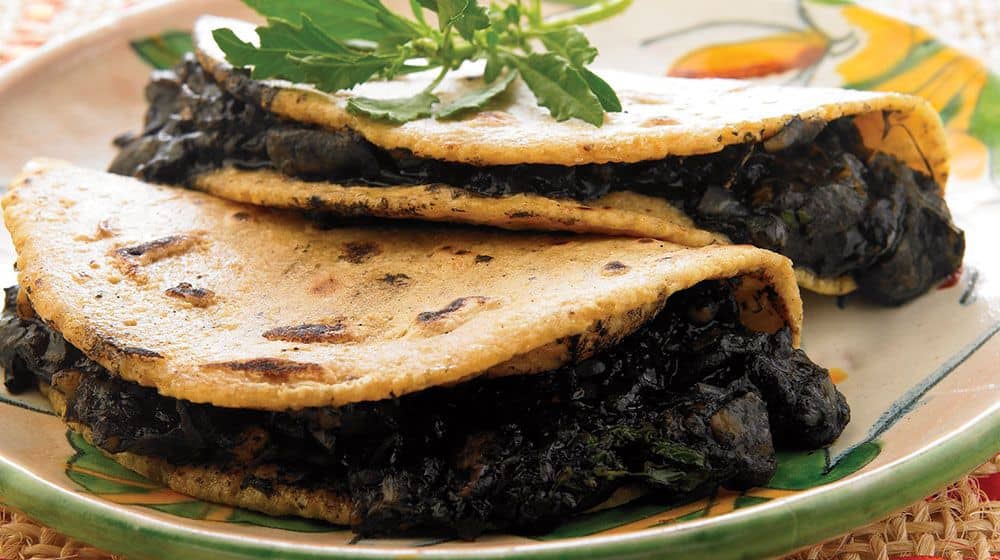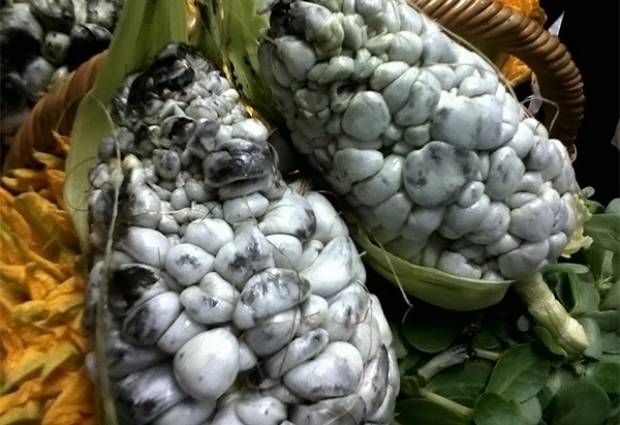The Aztec Caviar: Mexican Truffle Huitlacoche
The huitlacoche is an edible fungus, a parasite of corn, that has become a valuable product since it is excellent food and an important source of economic income for the producers who commercialize it.

Although it was once considered an annoying pest that attacked corn crops and was mercilessly exterminated, today the Mexican huitlacoche (or cuitlacoche) is considered a delicacy in countries like the United States, Germany, and France, where it is called the Aztec caviar or the Mexican truffle because of its intensely smoky flavor, a mixture of shiitake mushrooms and black truffles.
Huitlacoche, an ignored delicacy
Huitlacoche, also known as Mexican truffle (Ustilago maydis), is a parasitic fungus that grows on corn during the rainy season. On the one hand, it is considered a pathogen and a devastating disease for corn (Zea mays) producing countries that mainly infects the young plant, which develops malformations that are initially pale gray, which, as it matures, acquires the black color that characterizes it, which is why it is called corn charcoal.
In Mexico, where there is an ancestral culture of corn planting, this fungus has begun to be cultivated in a controlled manner because it is considered a delicacy, or "food of the gods", standing out as a culinary delight, as well as a food alternative for its nutritional and functional characteristics. It is mainly consumed in quesadillas, soups, and stews.

In addition to its exquisite flavor, huitlacoche contains essential fatty acids (oleic and linoleic) that are sources of -3 and -6, respectively, which are precursors of many substances involved in the regulation of blood pressure and inflammatory responses. It also contains essential amino acids, mainly lysine, which aid calcium absorption and promotes collagen formation. It provides up to 14.2 g/100 g of protein. It also contains fiber, vitamin C, minerals (mainly phosphorus, which is an essential part of bones and teeth), and caloric content of 248.53 kcal/100 g.
Attention to this food has increased over time, as it is considered an alternative source of nutrients; it has proven to be prebiotic and contains bioactive compounds, including phenolic acids and flavonoids, which are responsible for different positive effects on human health, as it has shown antioxidant, antimutagenic, and anticarcinogenic activities, among others.
Huitlacoche is not fully accepted by diners as it is a mushroom with an ashy appearance. It can be unpleasant to the eye and the palate, so it is important to promote it so that its consumption is valued.
Currently, laboratories of the Center for Research in Food and Development (CIAD) are researching this traditional Mexican mushroom, focusing their efforts on highlighting its rich nutritional profile as well as on obtaining and analyzing its bioactive compounds of phenolic nature, in addition to their bioaccessibility and bioavailability, which will allow them to know to what extent these bioactive compounds could exert their beneficial activities on human health.
It is expected that the results of this research will provide valuable information on the phytochemical composition of this delicious food and its role in reducing the risk of diseases; all this to promote the consumption of a native food that, in addition to being a gastronomic delight, provides health benefits.
Science: A Mushroom of the Mexican Cuisine
The cuitlacoche (Ustilago maydis) is currently the mushroom most linked to the Mexican culinary tradition. In the rainy months, we look for the corn covered by this organism in the markets, partly to ensure that it is fresh food, but also because of the image of corn, mushrooms, and corn melting.
But in front of this reality, we have another: as this mushroom does not have hard parts, there is no archaeological data that suggests its use in Mesoamerica and there is nothing in the iconographic aspect. Bernardino de Sahagún (16th century), General History of Things in New Spain, where it finally appears, but not as food, but as something called cujtlacochi, which is described as dirt that grows on top of the corn. This means that before the arrival of the Spaniards, it wasn't eaten and was seen as a problem in the cornfields. This begs the question: how did this fungus become a traditional Mexican food?
To solve this unknown, let's go back to the triad of milpa-maiz-cuitlacoche and see it from an evolutionary perspective. Let's remember that corn (Zea mays) is a domestic plant whose wild ancestor is a macollo called "teosinte" (Zea perennis). The process resulted in tall, single-stemmed plants and, above all, larger and larger ears, from one with few grains to the current cobs.
This process benefited mankind and other characters. Grasses are regularly parasitized by fungi of the genus Ustilago, recognizable only when the spike loses its consistency and is transformed into black powder, like ash, which is the spores. In the case of the cuitlacoche, when it invades the future ear, it alters its development and transforms the grains of the corn into bodies called soros, which when they grow into sacs, and when they mature, break and release something like mud, the spores.

The set of soros is what we recognize as cuitlacoche, and its dimensions are the result of the amount of food available, so we can ensure that the evolution of the corn spike and the size of the fungus were simultaneous, and so people faced this peculiarity, or, rather, discomfort, because it was a part of lost food.
This condition was common throughout the pre-Hispanic period. So at what time did Ustilago maydis cease to be a nuisance and become food? In the traditional cornfields, numerous organisms coexist, some cultivated or bred and others that occupy this area, and it is a man who decides what he uses and how. Perhaps the most humble indigenous peasants consumed cuitlacoche in critical moments, but only they and without it being part of their food tradition.
But as time went on, especially during Mexico's social crisis in the 1800s, people had to look for food wherever they could find it. This humble mushroom's use grew over time, but it was always associated with poverty and being an indigenous person, so it was never served on the plates of any other social or economic group.
Easy Huitlacoche recipe
Ingredients
600 gr clean huitlacoche, coarsely chopped
4 (500 gr) poblano chiles, roasted, skin and seeds removed, cut into thin slices
2 (30 ml) cloves garlic, peeled, finely chopped
3 branches of epazote
100 g fresh cheese, sliced
Corn tortillas
Salt
Preparation
Heat the chosen oil and fry the onion, garlic, and poblano slices. Add mushrooms, cover, and keep low heat for 10 minutes or until mushrooms are tender, but not soft or disrupted. Finally, add the epazote and season. Before serving, remove the epazote sticks, and accompany the slices of cheese and hot tortillas.




